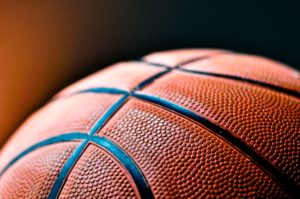 One of the things that makes basketball a great sport is that you don’t need much equipment to practice. It’s easy to say, “NO, you need a hoop and a court, and basketball shoes, and….”, but real basketball players have made hoops out of everything from milk crates to baseball hats jammed upside down in the top of their door.
One of the things that makes basketball a great sport is that you don’t need much equipment to practice. It’s easy to say, “NO, you need a hoop and a court, and basketball shoes, and….”, but real basketball players have made hoops out of everything from milk crates to baseball hats jammed upside down in the top of their door.
Many times, a pair of socks has been used as a basketball! When I played in college, our team would do “walk-throughs” in hotel conference rooms and sometimes the ice bucket or a shoe served as our basketball!
However, the most important “training” tool a basketball player can have is a basketball! If you have a basketball you can work on ball handling, passing, shooting (even without a hoop), and more. Growing up in snowy northwestern Pennsylvania, there was a long stretch of the year where it was tough to play outside. Yes, I did shovel the driveway to play sometimes. But realistically, that wasn’t always an option. I spent HOURS in the best indoor basketball pretend court I could find… my cold, dark basement!
In truth, any basketball will do, but we want to share with you some more information on basketballs. Today, we are going to focus on indoor basketball and help you decide on the best indoor basketball. (Follow these links if you are looking for details on the best basketball books or best basketball gifts
Let’s start with some of the basics to learn the sizes of basketballs and the material of basketballs
Basketball Sizes
Men’s and Boys basketball leagues use the same size ball pretty much from ages 12 right through to the NBA. This is a 29.5” basketball which is also called a size 7 basketball. Grade/middle school, High School, College, and the NBA all use a 29.5” basketball. This ball is often called a “Men’s Ball”
Women’s and girls’ basketball leagues use the same ball from age 12 to the WNBA, but they use a slightly smaller ball. Women use a 28.5” basketball, which is also called a size 6 basketball. This ball is often called a women’s ball.
Younger players aged 9-12 will usually use a 27.5” basketball/size 6.
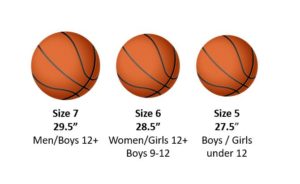
There are smaller versions of basketballs intended for kids under 9 years old. There is a 27.5” basketball and even smaller versions intended for very young kids.
Basketball Materials
There are three types of materials used for basketballs: Real leather, Composite leather (or synthetic), and rubber. Our focus here is on the best indoor basketball, so we are going to focus on leather and synthetic because rubber is not an indoor basketball material.
One thing that surprises a lot of people is that the NBA (and some other professional leagues) uses a different type of ball than college, high school, and everyone else. When people feel the real NBA ball, they are shocked! The NBA uses a REAL leather basketball and everyone else uses composite leather. The WNBA uses composite leather.
Leather
A leather basketball is the real deal. It is what the pros use. In 2006 the NBA ran a very bad experiment. The NBA tried to change to a composite ball and the pros HATED it. Players hated the way it felt. It was measured the ball didn’t bounce as high and it bounced 30% less predictably. The biggest difference between a leather basketball and a composite leather ball is how they react to wet hands, sweat, and any other liquid. NBA players sweat A LOT during a game and composite balls get slippery when they are wet. However, a real leather ball barely changes. Sweaty hands almost help with the grip on a leather basketball. Needless to say, after just a couple of months, the NBA went back to the old leather ball. Leather balls are rarely used outside of professional basketball. The leather ball is more expensive and requires some “break-in” time. They are also less durable. There are only a couple of good real leather options, the Wilson NBA Official Game Basketball and the Molten BG5000 (used in many international professional leagues)
Composite Leather
This is the ball pretty much everyone knows as a nice indoor basketball. These composite leather basketballs are used by almost every college, high school, and middle school. These are the Wilson Evolution, The Wilson Evo NXT, Baden Elite, Spalding Legacy TF-1000, Nike Elite, and the Molten FIBA GG7x (used for many international professional leagues). Composite leather has a little bit better grip with dry hands and it has a nice soft feel. Most people prefer composite leather unless they are used to playing with real leather. Composite leather basketballs are cheaper than real leather, cost less, and are durable. The biggest drawback to composite leather is probably the way they get slippery when they are wet.
Best Indoor Basketball (composite)
Now that you know the basics, let’s get into finding the best indoor basketball. Realistically, having a favorite indoor basketball depends on personal preference. I think ten years ago there would be more clear-cut winners, but in recent years the products have improved across the board and now many brands make a viable high-end composite leather basketball.
Not everyone will agree on what the best indoor ball is, but there are some definite favorites out there. Our favorite is the Wilson Evolution. The best value is The Rock Core 2 Cover.
The Best
Wilson Evolution
The evolution is the gold standard for indoor basketballs. It’s been around for a number of years, and subsequent efforts (like the Evo NXT) don’t feel as authentic to most basketball fans. The Evo has a nice soft cushion feel, its weight feels balanced, and it is easy to control while dribbling.
The Best Value
The Rock Core 2 Cover
The Rock doesn’t get quite the love they deserve because they just aren’t as well known or in the spotlight. However, they make a high-end indoor basketball at a low price point compared to their competitors. Fans of the Core 2 Cover say it is every bit as good as the Evo, just doesn’t have the star power behind it and it isn’t as widely available. Definitely a great option as you can usually find it for less than $50.
Other top-tier indoor basketballs (composite leather)
Baden Elite
Another brand that is not quite as well known as Wilson or Spalding. However, Baden’s basketballs are highly respected and they are of high quality. As of writing this review, the Baden Elite has a 4.8/5.0 on Amazon for their reviews.
Wilson Evo NXT
The Wilson Evo NXT was Wilson’s attempt at surpassing the Evolution. This ball definitely has some fans, but even on Wilson’s website, this ball ranks lower than the Evolution. It has a different feel than our other top-tier balls (Evolution, Baden Elite, and The Rock). It feels a little lighter, a little bouncier, and it’s a little brighter (which some people don’t like).
The other high-end options… the second-tier (composite leather)
Nike Elite
Nike is newer to the basketball game and has never really gotten the traction in the market they want. These basketballs are okay to play with but don’t have as good a feel as our top-tier balls. They seem to be worse when wet than most balls and don’t feel quite the same when dribbling. (keep in mind, this is still a far superior ball to $20-$30 low-end composite balls).
Spalding TF-1000
Spalding is one of the OGs of the composite leather basketball game. I think they were responsible for making the infamous ’06 NBA composite ball. This is a fairly high-quality ball, but people who don’t like it complain about it feeling more like “plastic”. I am not a fan of the TF-1000. In one league I played in, someone would always make sure they brought an Evo because that gym only kept TF-1000 on hand. I think it is the worst of the high-end indoor basketballs (similar to the Nike ball, keep in mind this is still a far superior ball to $20-$30 low-end composite balls).
The Best Real Leather Basketballs
There are only two real options here.
Wilson NBA
The main option is the Wilson NBA game ball. Give it a try. It’s nice to experiment with different balls, it will only make you a better player
Molten BG5000
The other option is the Molten ball which is used in most the International Basketball Leagues.
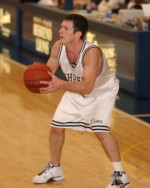 He has 25 years of experience playing basketball, training basketball players, and coaching basketball. The World of Hoops provides intelligent and intense basketball training to take basketball players to the next level.
He has 25 years of experience playing basketball, training basketball players, and coaching basketball. The World of Hoops provides intelligent and intense basketball training to take basketball players to the next level.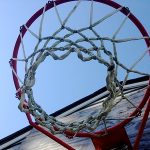 The Best Basketball Gifts and Products
The Best Basketball Gifts and Products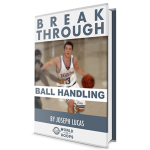 A Great Investment – Breakthrough Ball Handling
A Great Investment – Breakthrough Ball Handling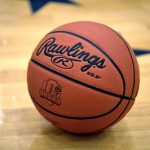 Ball Handling Improvement – The Proof
Ball Handling Improvement – The Proof




Speak Your Mind